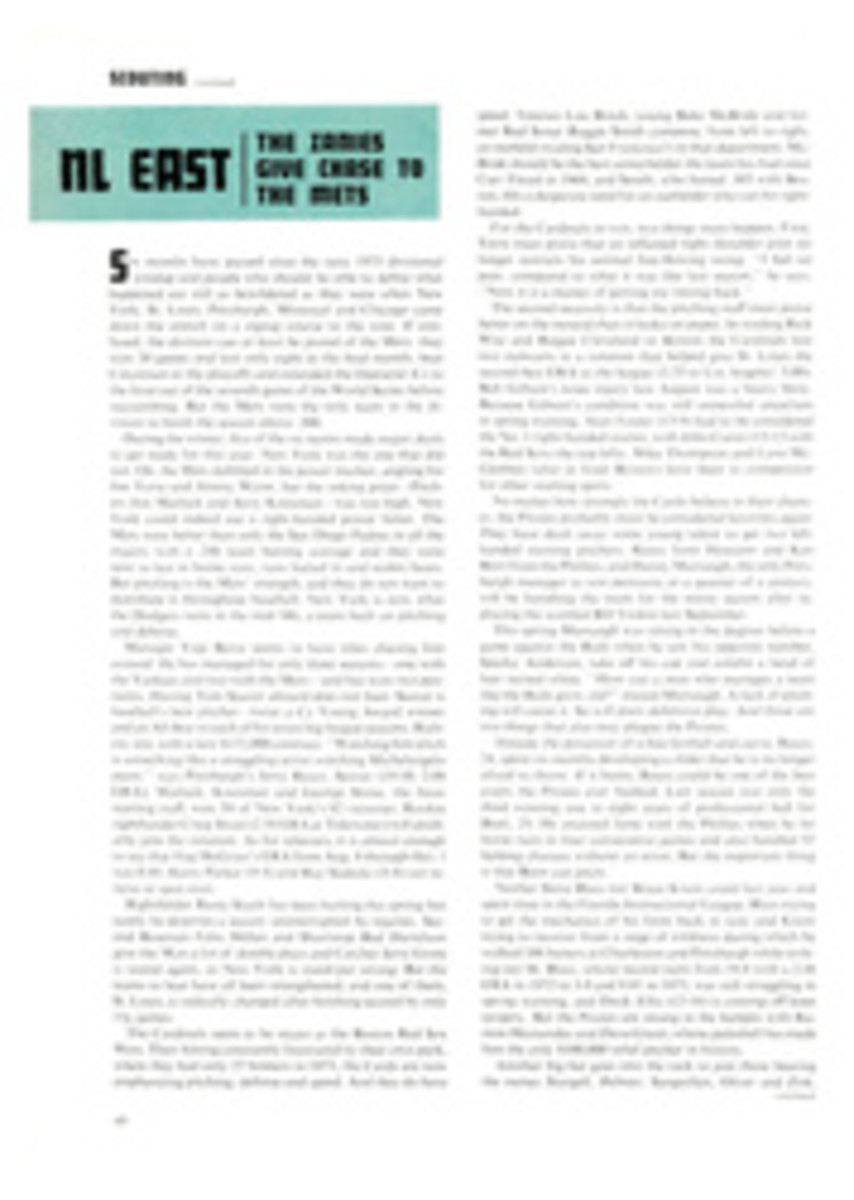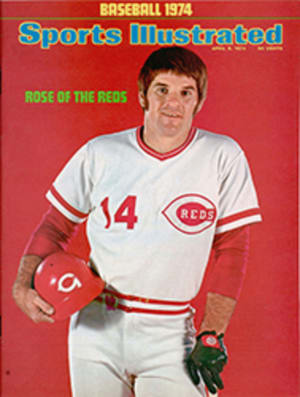
AL EAST: NO ONE SINGS THE BLUES IN BIRDLAND
The oddsmakers see the Orioles as even-money favorites to win a fifth East championship in six seasons, and no wonder. By averaging 99 victories a year since 1969 Baltimore has established at least a mini-dynasty. Drawing upon abundant reserves, Manager Earl Weaver wisely made the Birds a running club in '73 instead of waiting for the team's supposed batting power to assert itself. The Orioles obligingly led the league with 146 stolen bases, picked up 52 base hits on bunts and set an alltime collective base-stealing record as eight players had 10 or more each. While running merrily themselves, the Orioles could enjoy the run-suppressing abilities of a pitching staff led by Cy Young Award winner Jim Palmer (22-9), who is 57 games on the plus side of .500 over five seasons and has a career won-lost percentage of .682.
Now lefthander Ross Grimsley, 24, has come over from Cincinnati to join Palmer, veterans Dave McNally and Mike Cuellar and young Doyle Alexander, who had spells of tendinitis but finished the season in good order. The bad news for Oriole fans is that McNally was not throwing well in early exhibition games and that Cuellar broke a toe, an injury that can be particularly rough on a pitcher. Grimsley, 37-25 with the Reds, at least puts the Orioles in tune with the current fascination with the occult. "In Cincinnati I won a few games and hit a bad streak," he says. "I was introduced to a witch who gave me a charm—a stone wrapped in wire. I won three in a row, then lost the stone and went bad. She sent me another one and the same thing happened all over again."
Should Palmer & Co. fail to bewitch the opposition consistently, the lefty-righty bullpen combination of Grant Jackson and Bob Reynolds has a little magic of its own. They won 15 games and saved 18 others, losing but five last year.
Catcher Earl Williams is feeling optimistic after a troubled but not disastrous 1973. He led the club in homers with 22 and finished second in RBIs—83 to Designated Hitter Tommy Davis' 89—although batting only .237. "My catching has improved to the point where I'm no longer embarrassed to go behind the plate," says Williams. "Now I have the confidence of my teammates."
Baltimore's four-man outfield of Paul Blair, Don Baylor, Rich Coggins and Al Bumbry is swift and good. Bumbry, batting .337, was the league's Rookie of the Year, and Coggins (.319) batted .352 after the All-Star break. The infield is superior at second (Bobby Grich), shortstop (Mark Belanger) and third (Brooks Robinson), and Boog Powell is hitting long drives after a season of shoulder problems.
If the oddsmakers like the Orioles, the nation's van lines love the Red Sox. Rarely have so many pitchers moved to one team in such numbers. It took $100,000 to get Juan Marichal, a certain Hall of Famer, into a Red Sox uniform, and two spectacular trades with St. Louis delivered Rick Wise, Reggie Cleveland and Diego Segui (plus outfielder Bernie Carbo) to the new Boston manager, Darrell Johnson. In yet another maneuver Dick Drago, a 41-game winner in his last three seasons at Kansas City, became a Soxer. If this abundance of talent converts the Red Sox into a genuine threat it will not be surprising to the Orioles, who have had more than trouble enough with Sox pitching in the past.
But Boston has question marks as tall as that green wall in left field. Is Shortstop Luis Aparicio over the hill at 39? Could Carlton Fisk be overrated by both himself and the Boston press? Will a spring back injury to Second Baseman Doug Griffin again curtail his effectiveness? Wasn't Rico Petrocelli out for almost the final third of the season with a bad elbow? Who stole Yaz' home-run stroke, and how do you replace a Reggie Smith? At least one thing is clear: Boston now is going for pitching, speed and defense instead of trying to hit everything over its wall.
The Red Sox' most pressing problem will be the left side of the infield. At his best, Petrocelli is only acceptable as a third baseman, and ground balls have been scooting by Aparicio for the last three years. Rick Burleson is a young shortstop of whom much is expected.
It is temptingly easy to dismiss the Detroit Tigers from serious consideration as contenders because of age. And the Tigers are old: Al Kaline and Norm Cash are 39, Gates Brown, Woodie Fryman and Jim Northrup are 34, Mickey Lolich 33, Bill Freehan and Ed Brinkman 32.
This season is especially important to Kaline, because his .255 last year dropped his lifetime average to .299. Two decades ago he arrived in Detroit for his first full season and banged out 139 hits. This could well be his last year, and 139 more hits would make him the 12th man in history to reach 3,000. New Manager Ralph Houk has programmed Kaline into the DH spot, where the Tigers were expected to be strong in '73 but somehow missed.
Fielding, not hitting, is the Tigers' strong suit, and the slickest gloves belong to Third Baseman Aurelio Rodriguez and Shortstop Brinkman. Newcomers John Knox and Gary Sutherland may be alternated at second, while Norm Cash hopes to play 130 games at first. But rookie Ron Cash (no relation) crashes in after some impressive .300 minor league stops, plus a .410 average in 14 late-season games with the Tigers. Freehan is fine behind the plate but no terror at it. Willie Horton, Mickey Stanley and Northrup return in the outfield.
For all the talk of Tug McGraw, Mike Marshall and Roland Fingers, the best relief pitcher in baseball last year was John Hiller, who won 10 games, saved 38 others and appeared in 56% of Detroit's wins while compiling a 1.44 ERA. For starters the Tigers have 23-game winner Joe Coleman, 16-game winner Lolich, Fryman and Lerrin LaGrow. But pitching can't do it all. The team may fall below .500 for only the second time in a decade.
Milwaukee, the town the Braves abandoned in 1966, became a million-fan city again as the young Brewers played spirited ball for a good part of the season only to finish fifth, 23 games behind Baltimore. "Most of us have been together for three years," says the $100,000 first baseman, George Scott, ""and we should be a lot better ball club."
In order to become one the Brewers will have to show improvement in their pitching. Hoping to do just that, they picked up Clyde Wright from California, where he had won 22, 16 and 18 games before last year's dip to 11-19. Wright joins 20-game winner Jim Colborn and Jim Slaton (13-15) to give the Brewers three genuine starting pitchers—riches they have not known since birth as the Seattle Pilots five years ago. Ready to help Scott at bat (.306, 107 RBIs) are Centerfielder Dave May (.303, 25 home runs) and Third Baseman Don Money (.284). Ex-Angel Outfielder Ken Berry (.284) is a top defensive man. Because they could not turn up a productive DH the Brewers are giving Felipe Alou, soon to be 39, a chance.
Moving in to share Shea Stadium with the Mets following a fourth-place—and folding—year at Yankee Stadium, New York is a ragged team. And sound baseball man though he is, quiet Bill Virdon will not awaken echoes of charismatic Yankee managers of the past—or near-managers like Dick Williams, who was New York's first choice. Nevertheless, the Yankees do have some hitting in the bats of Centerfielder Bobby Murcer (.304), Catcher Thurman Munson (.301), First Baseman-Outfielder Ron Blomberg (.329 against righthanders; lefties he wasn't exposed to) and ex-Royal Outfielder Lou Piniella (.285 lifetime). Munson's homer total of 20 should go up at Shea.
But for the Yanks to be taken seriously, Pitchers Pat Dobson (9-8), Sam McDowell (5-8) and Steve Kline (4-7) will have to complete some games and Fritz Peterson will have to reverse his 8-15 record. At least George (Doc) Medich did a fine job in his first full year with New York, finishing at 14-9. Sparky Lyle's contract dispute leaves that marvelous relief pitcher something of an enigma. Wayne Granger, "Fireman of the Year" with Cincinnati in 1969 and 1970, will not suffer from underwork.
Cleveland's last-place Indians hit more homers (158) than any other team in the league, while its pitching staff yielded more than any other in the majors (172). Unfortunately, that imbalance may well carry over into '74. Among the lustiest homer-hitters are Charlie Spikes (23), Oscar Gamble (20), George Hendrick (21), Buddy Bell (14) and Dave Duncan (17). Hendrick, the 24-year-old centerfielder, is a name to put in your hat for the future. Frank Robinson says he could become the best player in baseball, if "truly motivated." But the golden boy of the Indians right now is the 22-year-old Bell, who led the club in seven categories while successfully making the switch from the outfield to third base.
Ah, yes, those pitchers who threw the gopher balls. Prominent among them were Gaylord Perry (19-19) and Dick Tidrow (14-16). They have been joined by Gaylord's brother Jim (14-13 with Detroit). But whether the ball stays in for them or goes out will be overshadowed by larger doings in Baltimore and Boston.
PHOTO
FIREBALLING JIM PALMER COMES OFF A 22-WIN SEASON AT THE HEAD OF A PITCHING CORPS MORE CAPABLE THAN MOST
Scouting Reports were written by William Leggett and Ron Fimrite, aided by Jim Kaplan and William T. White

